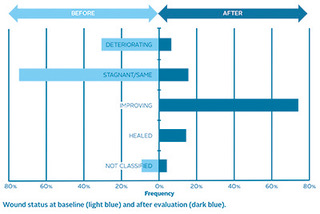References
Banin E, Brady KM, Greenberg EP (2006) Chelator Induced Dispersal and Killing of Pseudomonas aeruginosa Cells in Biofilm. Appl Environ Microbiol 72: 2064–9
Beveridge TJ, Fyfe WS (1985) Metal fixation by bacterial cell walls. Canadian Journal of Earth Sciences 22(12): 1893–8
Bjarnsholt T, Eberlein T, Malone M (2017) Management of wound biofilm made easy. Wounds International, London. Available at www.woundsinternational.com
Bowler PG, Parsons D (2016) Combatting wound biofilm and recalcitrance with a novel anti-biofilm Hydrofiber wound dressing. Wound Medicine 14: 6-11
Bowler PG (2018) Antibiotic resistance and biofilm tolerance: a combined threat in the treatment of chronic infections. JWC 27(5): 273–7
Chen X, Stewart PS (2000) Biofilm removal caused by chemical treatments. Wat Res 34: 4229–33
Guest JF, Ayoub N, Mcllwraith T et al (2015) Health economic burden that wounds impose on the National Health Service in the UK. BMJ Open. doi:10.1136/bmjopen-2015-009283. Available from http://bmjopen.bmj.com
Gurjala AN et al (2011) Development of a novel, highly quantitative in vivo model for the study of biofilm-impaired cutaneous wound healing. Wound Rep Reg 19: 400-410
Hobot JA, Walker M, Newman GN, Bowler PG (2008) Effect of Hydrofiber® wound dressings on bacterial ultrastructure. J Electr Micro 57: 67-75
Holby N et al (2015) ESCMID guideline for the diagnosis and treatment of biofilm infections 2014. Clin Microbiol Infect 21: S1–S25
Hurlow and Bowler (2012) Hurlow, Bowler. Potential implications of biofilm in chronic wounds: a case series. J Wound Care 21: 109–19
Hurlow J, Couch K, Laforet K et al (2015) Clinical biofilms: A challenging frontier in wound care. Advances in Wound Care 4(5): 295–301
Malone M et al (2017) The prevalence of biofilm in chronic wounds: a systematic review and meta-analysis of published data. JWC 26(1): 20–25ma 2013; 1: 5-12
Metcalf D, Bowler P (2013) Biofilm delays wound healing: a review of the evidence. Burns Trauma 1: 5–12
Metcalf D, Parsons D, Bowler P (2017) A next-generation antimicrobial wound dressing: a real-life clinical evaluation in the UK and Ireland. J Wound Care 25(3): 132–8
Murphy C, Atkin L, Swanson T, et al (2020) International consensus document. Defying hard-to-heal wounds with an early antibiofilm intervention strategy: wound hygiene. J Wound Care 29(Suppl 3b): S1–28
Parsons D, Meredith K, et al (2016) Enhanced Performance and Mode of Action of a Novel Antibiofilm Hydrofiber® Wound Dressing. Biomed Res Int 2016: 7616471.
Percival SL, Bowler PG (2004) Biofilms and their potential role in wound healing. WOUNDS 16: 234–40
Percival SL, Mayer D, Kirsner RS et al (2019) Surfactants: Role in biofilm management and cellular behaviour. International Wound Journal 16: 753–60. https://doi.org/10.1111/iwj.13093
Said J, Walker M, Parsons D, Stapleton P, Beezer AE, Gaisford S (2014) An in-vitro test of the efficacy of an anti-biofilm wound dressing. Int J Pharmaceutics 474: 177–181
Seth AK, Zhong A, Nguyen KT, et al (2014) Impact of a novel, antimicrobial dressing on in vivo, Pseudomonas aeruginosa wound biofilm: quantitative comparative analysis using a rabbit ear model. Wound Repair Regen 22: 712–719
Wolcott R, Rumbaugh KP, James G et al (2010) Biofilm maturity studies indicate sharp debridement opens a time-dependent therapeutic window. JWC 19(8): 320–8
Wolcott R, Sanford N, Gabrilska R et al (2016) Microbiota is a primary cause of pathogenesis of chronic wounds. J Wound Care WUWHS Suppl 25(10): S33–43
Beveridge TJ, Fyfe WS (1985) Metal fixation by bacterial cell walls. Canadian Journal of Earth Sciences 22(12): 1893–8
Bjarnsholt T, Eberlein T, Malone M (2017) Management of wound biofilm made easy. Wounds International, London. Available at www.woundsinternational.com
Bowler PG, Parsons D (2016) Combatting wound biofilm and recalcitrance with a novel anti-biofilm Hydrofiber wound dressing. Wound Medicine 14: 6-11
Bowler PG (2018) Antibiotic resistance and biofilm tolerance: a combined threat in the treatment of chronic infections. JWC 27(5): 273–7
Chen X, Stewart PS (2000) Biofilm removal caused by chemical treatments. Wat Res 34: 4229–33
Guest JF, Ayoub N, Mcllwraith T et al (2015) Health economic burden that wounds impose on the National Health Service in the UK. BMJ Open. doi:10.1136/bmjopen-2015-009283. Available from http://bmjopen.bmj.com
Gurjala AN et al (2011) Development of a novel, highly quantitative in vivo model for the study of biofilm-impaired cutaneous wound healing. Wound Rep Reg 19: 400-410
Hobot JA, Walker M, Newman GN, Bowler PG (2008) Effect of Hydrofiber® wound dressings on bacterial ultrastructure. J Electr Micro 57: 67-75
Holby N et al (2015) ESCMID guideline for the diagnosis and treatment of biofilm infections 2014. Clin Microbiol Infect 21: S1–S25
Hurlow and Bowler (2012) Hurlow, Bowler. Potential implications of biofilm in chronic wounds: a case series. J Wound Care 21: 109–19
Hurlow J, Couch K, Laforet K et al (2015) Clinical biofilms: A challenging frontier in wound care. Advances in Wound Care 4(5): 295–301
Malone M et al (2017) The prevalence of biofilm in chronic wounds: a systematic review and meta-analysis of published data. JWC 26(1): 20–25ma 2013; 1: 5-12
Metcalf D, Bowler P (2013) Biofilm delays wound healing: a review of the evidence. Burns Trauma 1: 5–12
Metcalf D, Parsons D, Bowler P (2017) A next-generation antimicrobial wound dressing: a real-life clinical evaluation in the UK and Ireland. J Wound Care 25(3): 132–8
Murphy C, Atkin L, Swanson T, et al (2020) International consensus document. Defying hard-to-heal wounds with an early antibiofilm intervention strategy: wound hygiene. J Wound Care 29(Suppl 3b): S1–28
Parsons D, Meredith K, et al (2016) Enhanced Performance and Mode of Action of a Novel Antibiofilm Hydrofiber® Wound Dressing. Biomed Res Int 2016: 7616471.
Percival SL, Bowler PG (2004) Biofilms and their potential role in wound healing. WOUNDS 16: 234–40
Percival SL, Mayer D, Kirsner RS et al (2019) Surfactants: Role in biofilm management and cellular behaviour. International Wound Journal 16: 753–60. https://doi.org/10.1111/iwj.13093
Said J, Walker M, Parsons D, Stapleton P, Beezer AE, Gaisford S (2014) An in-vitro test of the efficacy of an anti-biofilm wound dressing. Int J Pharmaceutics 474: 177–181
Seth AK, Zhong A, Nguyen KT, et al (2014) Impact of a novel, antimicrobial dressing on in vivo, Pseudomonas aeruginosa wound biofilm: quantitative comparative analysis using a rabbit ear model. Wound Repair Regen 22: 712–719
Wolcott R, Rumbaugh KP, James G et al (2010) Biofilm maturity studies indicate sharp debridement opens a time-dependent therapeutic window. JWC 19(8): 320–8
Wolcott R, Sanford N, Gabrilska R et al (2016) Microbiota is a primary cause of pathogenesis of chronic wounds. J Wound Care WUWHS Suppl 25(10): S33–43



